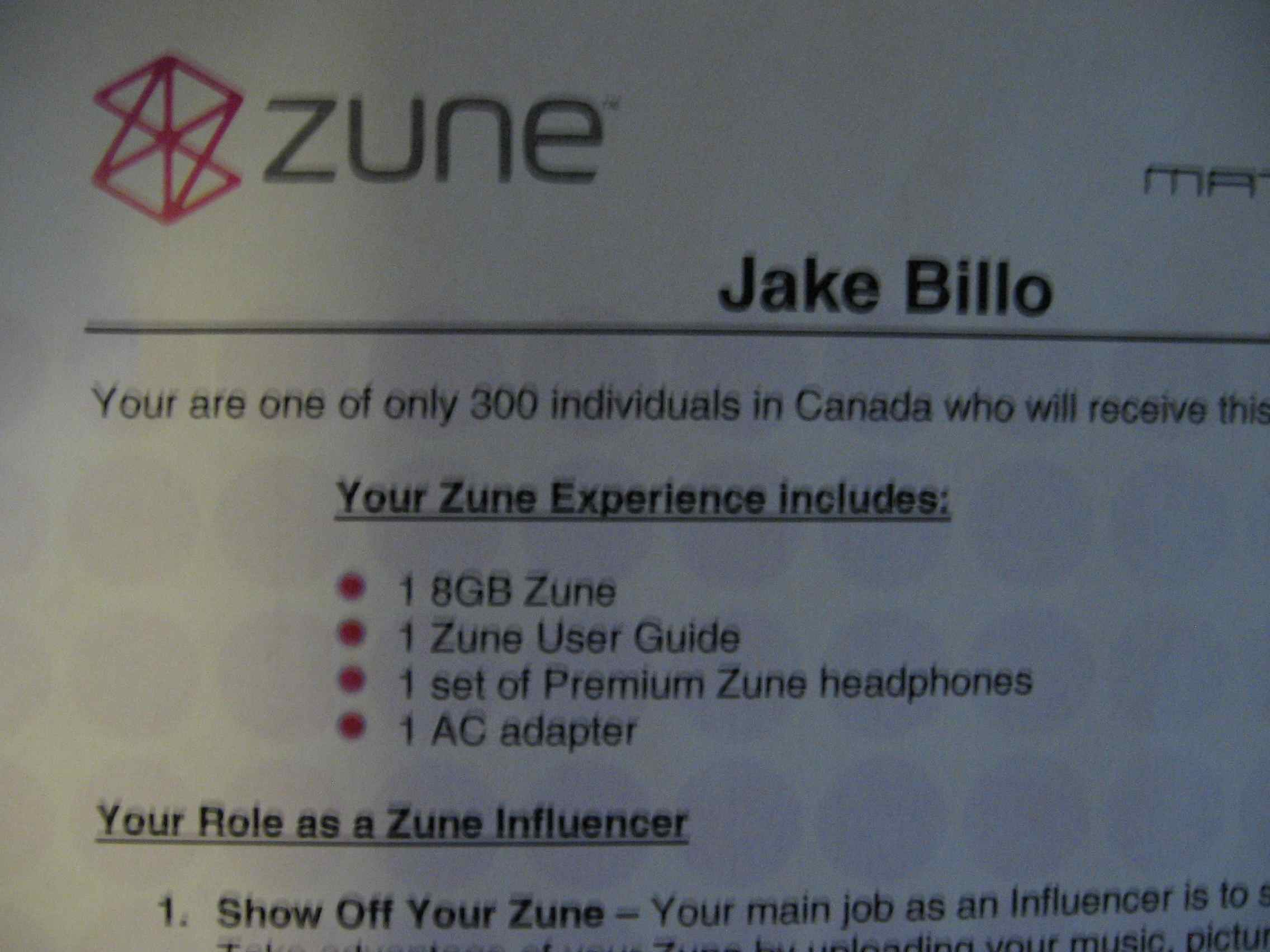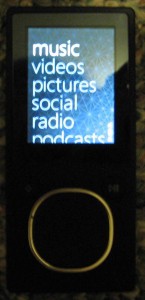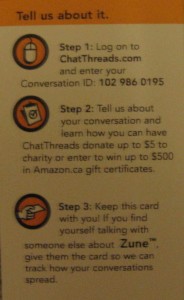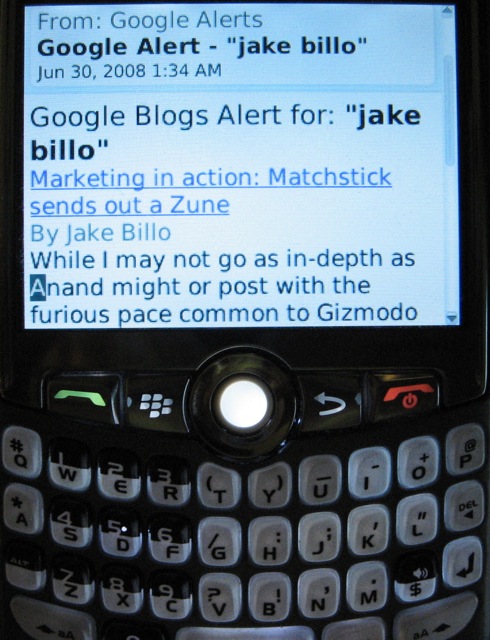While I may not go as in-depth as Anand might or post with the furious pace common to Gizmodo authors, I enjoy reviewing new technology purchases from a few different perspectives. As a Computer Science student, tech is interesting because it’s a practical application of concepts such as linked lists and binary trees and software architecture – and how most of those concepts get thrown out the window in order to ship on time.
From a business perspective, having firsthand experience with some of the same devices our clients use is helpful from a support angle. It also determines whether we’ll recommend them to end users. I’ve had great experiences with Asus mainboards, and every system I quote includes one – the (potentially) reduced cost of going with something else is not worth the extra aggravation it causes.
And then there’s the geek who talks about RAID-5 controllers just because they’re awesome.
Free Zune, And It’s Not A Pyramid Scam?
SmartCanucks is a regular visit from my feed reader, and they’d posted an article about qualifying for a free MP3 player. Unlike most “free stuff” contests and promotional offers online, everything from SmartCanucks will be applicable to Canadians in some form. Further intrigue ensued when commenters suggested it wasn’t the traditional $20 low-end Shuffle device, but a Microsoft Zune player.
I’d heard about the Zune launching in Canada recently and had played around with one in March for a few minutes, during at an Infusion Angels conference in the Accelerator Centre. It seemed to have a nice UI, but it’s hard to judge when you’re already being inundated with the distinctly Microsoft flavour of the building and presenter. (The XNA conference was very entertaining, for the record, and very encouraging for third party developers.)
After applying through the online survey, I received a call a few days later from Matchstick asking some followup questions. Most of them were repeated from the original survey, but I expect the representative was checking for consistency; one of the biggest problems in obtaining statistics is making sure the interviewees don’t contradict themselves. Some other questions were intended to get a baseline for my pre-existing opinions about Microsoft, and I was also asked if I’d review the product on my site or other social networking connections.
When the question period was finished, I was told that I qualified to receive an 8GB Zune package and that I’d get the option to send one to a friend or recommend another user.

Since I just received the device on the 24th, the next few weeks will be interesting as I properly put the Zune through its paces and try the wireless functionality, as well as provide some technical details on the software. To give it a fair shake, I’ll use it in real-life situations before making a judgement call. I’ll be reviewing the hardware, software and online social service in separate articles over the next month or so, giving people the chance to add their own comments.

Above is the only obligatory image of the unit. There are already dozens of “unboxing” posts online – if you’re into that sort of thing, check out these other sites:
The Marketing Effort
For now, it’s probably worthwhile to talk about how the Matchstick (and ChatThreads) process is tinged with just enough marketing effort.
Let’s get one thing straight, though: a large number of people participating in this type of marketing effort go to great lengths to whinge on a certain subject. Namely, is accepting merchandise as part of a promotion ethical? There are dozens of posts from Matchstick’s Nokia 6682 efforts to this effect, with the gamut of predictable, tired reactions ranging from “I got an awesome phone for free!” to “these spammers killed my dog.”
I’m sick of this debate. Disclosing where you got the product is a significant part of the review process, and established press organizations have done this for years. If you don’t disclose your connections, you’re an astroturfer – in other words, the same as the company behind AllIWantForXmasIsAPSP.
Furthermore, being solicited for marketing campaigns is part of maintaining a reasonably popular site. How many press releases do you think Engadget receives daily? I actively sought out this opportunity, so I can’t make the same claim – but those who can’t seem to work out the “ignore” function in their email client or respond with a polite “no” need to seriously reconsider operating a website.
For this promotion, Matchstick has partnered with a company in the States called ChatThreads. Their purpose is to collect word of mouth responses and correlate them with online activity, and they deliver a set of cards as well as seek feedback though their website. Each card has a Conversation ID that links the original campaign, authorized end user, and the collected personal information.

Before receiving the Zune, ChatThreads sent an email asking me to sign up for their site, containing some interesting requests:
As part of your participation you will be sharing your feedback and conversations about Zuneâ„¢ with ChatThreads, an independent word of mouth research company working with Matchstick.
Each time you have a conversation about Zuneâ„¢ tell us about it at ChatThreads.com/zune. The conversations you tell us about could be face-to-face, over the phone, or online.
If you’d like to see exactly what the end-user survey entails, hit up ChatThreads’ site and enter the Conversation ID 102 986 0195. You’re all my friends!
My initial reaction to the page was that I certainly did not agree to provide email addresses every time I mentioned Zune to people. Even documenting conversations wouldn’t really be a problem – but signing people up for an email message looking like this is not something I’d be thrilled to try repeatedly. At least the “Providing this information is optional.” message at the bottom is present.
Another oddity involves the terms of use adorning the ChatThreads sweepstakes. As a thanks for completing the ChatThreads survey, you can opt to have the company donate up to $5 to specific charities, or win up to $500 in Amazon gift certificates. Unfortunately, even as this entire marketing campaign is intended for Canadian residents, the sweepstakes terms restrict the potential winners to zero.
Eligibility. Open to legal residents of the United States (excluding Rhode Island, Puerto Rico and all other U.S. territories and possessions outside of the continental United States and where otherwise prohibited by law)
Conversely, ChatThreads’ past winners page indicates someone from Toronto as a previously successful winner. At the very least, this point should be updated or clarified before sending out what looks like more-expensive-than-average marketing collateral.
I’ll be forwarding this post to the Matchstick coordinators to get a definitive answer through ChatThreads, before promising contest entries to card recipients. Update July 4/08: See this post for ChatThreads’ response and the corrected sweepstakes rules.
Another interesting element in the pseudo-viral marketing strategy is the ability to recommend someone for a Zune device. The signup page for this process required a weblog URL, regular visitor count and number of friends on a social network:

These requirements really discouraged a technologically adept friend of mine. While he’s active in online social networking, he doesn’t currently host an independent blog. The solution was to have him link his Facebook profile page – the “I just got a free Zune! It’s awesome!” status messages through Facebook are perhaps even better publicity from a marketing perspective than a series of posts.
What’s Next?
I’m interested in how Matchstick continues to follow up on this effort. The welcome letter indicated that there were more email messages and additional promotion possibilities in the future. Hopefully this post gives a bit of firsthand insight into the background process.
What can other companies and future marketing campaigns learn from what Matchstick and Microsoft did?
The good:
- Don’t set terms and conditions other than what’s needed for your target market. I never felt pressured to say anything “good” about the product, which is a better way of getting feedback than three hundred faux-positive MySpace comments.
- Attract technology-focused individuals. They’re more likely to be the recommenders and drivers of product adoption.
- Make it easy for people to get involved. Don’t single out people arriving from high-traffic sources: these are the people you want talking about your product.
The not-as-good:
- Try not to spam anybody who’s already expressed a lack of interest. With a Microsoft product especially, there are serious detractors in the Google search results already and they’re not as concerned about being offered a Zune, as they are with being offered a Zune.It’s always challenging to manage email campaigns. When working for Maplesoft – I did my best to ensure the programs marketing folks didn’t blast people that had already unsubscribed. (I can’t vouch for what they’re doing now, but I hope my email utility still has a good home.)
- Get all your terms and conditions lined up, especially when using external agencies. If people start finding inconsistencies in the fine print then they might start to wonder exactly how professionally the program is managed.
- Don’t assume that everyone manages a weblog or website. This may have been a specific target of the campaign, but some people are just as effective when posting to Facebook or other social networks. Keep the regular user – who isn’t necessarily a content producer – in mind too!
Your thoughts will help shape the upcoming reviews. What are you interested in hearing about – the service? Integration with other utilities? Metadata tagging and support for network shares within the software? Speak your piece in the comments and I’ll get on it!
Update, July 4/08:
This post is the first in the Zune review series. I received the device for free as part of a Matchstick promotion. My goal is to provide a technically engaging and impartial review for people interested in MP3 players. Other posts include:




